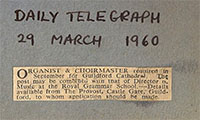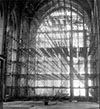
Guildford Cathedral 1960-1974: As it was in the beginning...
In 1927, the huge Diocese of Winchester had been divided, and two new Dioceses were created - Portsmouth and Guildford.
In Guildford, Holy Trinity Church was designated as the Cathedral Church, but it soon became clear that the building was too small. So, a year later, a decision was taken to build a new Cathedral, on a spectacular hilltop site outside the town, recently gifted to the Diocesan authorities.
For its design, a national competition was launched. Entries were submitted by 183 architects, and in 1933, Edward Maufe was announced as the winner.
Building began in May 1936, with the laying of the foundation stone by the then Archbishop of Canterbury, Cosmo Lang, and by the start of the war, the shell of the Transepts and Quire were complete, though left open to the elements.
No further building was possible throughout the war, or in the years immediately after, and it was not until 1951 and the arrival of the newly appointed Provost (Walter Boulton) that fund-raising began again, with a view to completing the building. This could not have happened without the expert financial skills of Eleanora Iredale, and by the end of the 1950's the great Nave was virtually complete.
It was left to Walter Boulton to formulate the pattern of Worship in the new Cathedral, and a Consecration date was fixed for Wednesday, 17th May 1961.
 Just over a year before, this advertisement appeared in the General columns of Situations Vacant in the Daily Telegraph. (Click the advertisement to see it in original size)
Just over a year before, this advertisement appeared in the General columns of Situations Vacant in the Daily Telegraph. (Click the advertisement to see it in original size)
At
that time, Barry Rose was in his second year at The Royal Academy of
Music as a mature student, and with over 100 others, he submitted his
application for the organist's post for the new Cathedral at Guildford.
After an audition at The Royal College of Music, and a highly
unsuccessful interview with two 'outside' musical assessors, Walter
Boulton offered the post to Barry. This was largely due to personal
recommendations from John Dykes-Bower (the organist of St.Paul's
Cathedral), Leslie Woodgate (then Director of the BBC Singers), and
Prebendary Gordon Phillips (then Chaplain to London University),
as well as the success Barry was achieving with his boy choristers at
St.Andrew's, Kingsbury.  The
surprise appointment was announced in the national and musical press,
and in September 1960, Barry moved to Guildford, to work with the
present pro-cathedral choir at Holy Trinity Church, and to lay the
foundations for a brand new Cathedral choir at Lanesborough School, a link which still continues today.
The
surprise appointment was announced in the national and musical press,
and in September 1960, Barry moved to Guildford, to work with the
present pro-cathedral choir at Holy Trinity Church, and to lay the
foundations for a brand new Cathedral choir at Lanesborough School, a link which still continues today.
The story of those early years has been well documented in Simon Carpenter's book The beat is irrelevant, (sadly, now out of print), but the former Choristers Association has recently issued a double CD of archive actuality recordings, spanning the years from 1961-1973.
As time passes, we hope to add more similar recordings to this website. None of these will have been previously published, so they, too, will constitute a unique archive, documenting the progress of the choir, from its early hesitant beginnings*, to the accomplished sounds of a few years later.
Watch this space............
| Click here to visit the ever-increasing YouTube audio libary of Archives of Sound, featuring live recordings of Guildford Cathedral Choir between 1961 and 1974 - a unique archive rescued from old and decaying tapes. |
*STOP PRESS:
We have managed to find a recording
of the very first BBC Choral Evensong broadcast from the Cathedral, on
18th October, 1961 - just 5 months after the Consecration. The audio
quality is not good, since, in those days, domestic tape recordings
were usually made by placing a microphone in front of the loudspeaker
of the radio, often leading to other background noises, as well as
distortion. It was also in the days before regular FM transmissions.
This recording has occasional background noise, as well as some obvious distortion, but as a piece of the early musical history of the Cathedral, it is unique, and if anyone who visits this website has a better quality version, we would be delighted to hear from them.
In this excerpt you can hear the opening announcement, and the second half of the bass solo aria from John Travers' anthem 'Ascribe unto the Lord', sung with great virtuosity by John Barrow, and brilliantly accompanied by Gordon Mackie, the Cathedral's first sub-organist.




